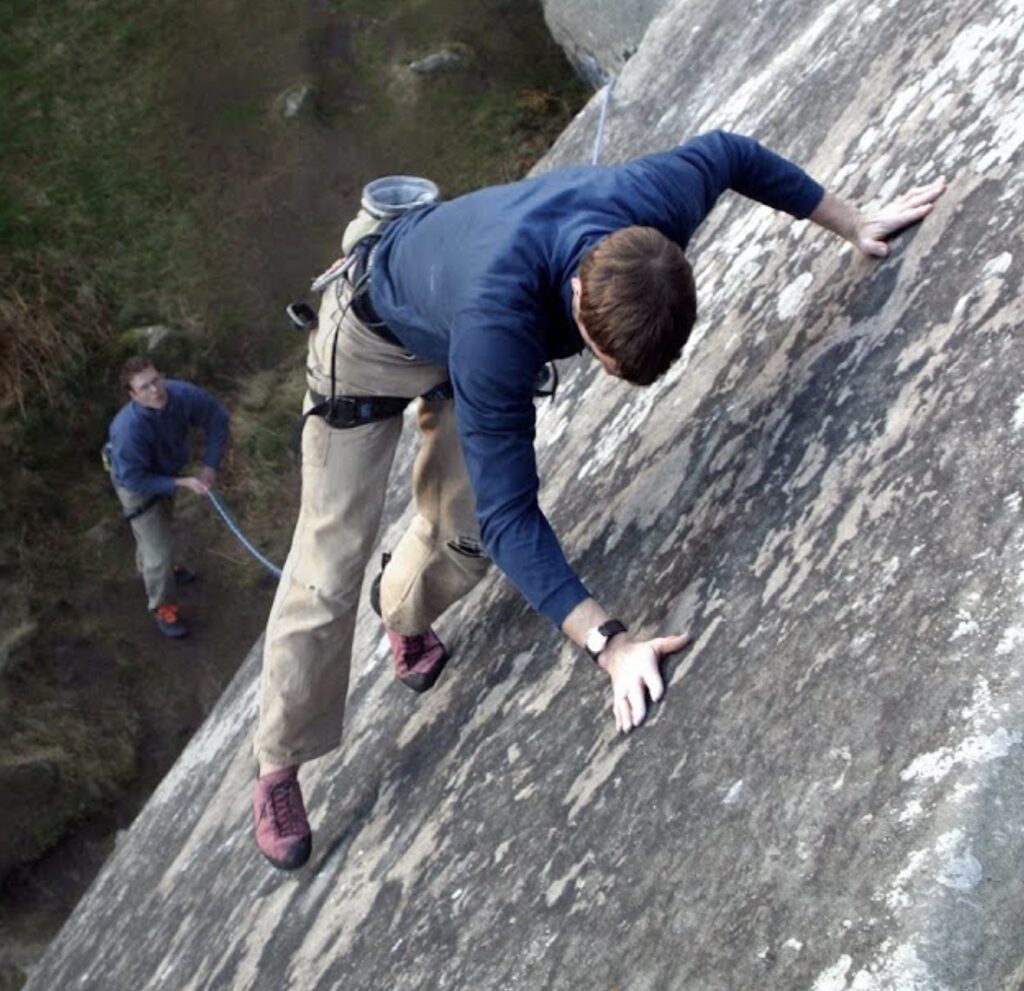Difficilmente gradabile, facilissima da sbagliare, con conseguenze estreme
Il luogo è il Northumberland scozzese, completamente al di fuori dei normali giri arrampicatori; non che non ci siano falesie o climbers, ma la meteo, le zanzare e la roccia non sempre alla moda rende questa porzione di Scozia decisamente di nicchia nell’immaginario collettivo verticale. Insomma si scala su quello che c’è e l’etica anglosassone, ancora parecchio ancorata non solo nelle vecchie generazioni ma anche radicata nei giovani, ogni tanto produce delle chicche rare che è giusto mettere in evidenza. Quella di “Dead on arrival”, dal nome di un vecchio film che non finisce bene, è una via che si può definire livellatrice: non occorre essere dei top climbers per poterla salire ma richiede equilibrio, calma, flow, testa di cemento anche se i movimenti non sono tantissimi. Le mani, come si può facilmente vedere dal video, fanno oggettivamente poco e servono più che altro per distribuire i chili in equilibrio mentre il corpo si sposta sapientemente a destra e a sinistra. La via era stata liberata da Tony Lickes con l’utilizzo della corda, quindi in stile trad, il che rende meno pericolose un paio di sezioni ma rende il tutto assai più rischioso in caso di caduta nelle altre zone della via. Scalarla in free solo, perché parlare di highball è un po’ riduttivo, assicura almeno una caduta in linea retta, forse con qualche probabilità in più di finire sui crash anche se ha una velocità da missile.
Ecco come Robbie Phillips presenta la sua salita, da pochi minuti documentata dal video su youtube:
“Ancora gravato dal polso infortunato, la mia esplorazione delle vie in placca più difficili del Northumberland mi ha riportato al Savage Slab di Back Bowden, dove ho iniziato a mettere insieme un’altra linea sul contrafforte. “Dead on Arrival” è stata salita per la prima volta all’inizio degli anni 2000 da Tony Lickes ma è stata ripetuta solo una volta lo stesso giorno. Da allora è stata quasi dimenticata, molto probabilmente a causa non solo della sua natura intensamente audace, ma anche del fatto che non è così facile vedere la linea e che ci sono altre linee più evidenti sulla placca, ovvero la “Tecnica Peak”, ” Savage Slab”, ecc… Dopo aver passato una giornata cercando di capire la linea, ho scoperto i movimenti che rendevano possibile la diagonale, e la linea è diventata molto più evidente.
Un ringraziamento speciale a Mark Savage per aver fornito le immagini di Tony Lickes sulla prima salita e ovviamente a Tony per aver immaginato la linea. La sua salita originale è stata fatta da capocordata Trad senza pad, che penso sia un modo molto più audace per scalarla. Potresti essere protetto per il 50% iniziale della salita, ma una caduta oltre quella sarebbe sicuramente una caduta a terra, e qualsiasi caduta presa vicino al centro si tradurrebbe in un orribile pendolo dal quale saresti fortunato a uscire indenne. .
La bellezza di salite come queste è che non si basano affatto sulla forza, ma solo sulla tecnica e su un forte gioco di testa, che rimuove la linea che così spesso separa gli scalatori più forti da quelli più deboli. Non importa se sali 6a o 9a, questa salita è alla portata di tutti, ma solo una piccola manciata sarà in grado di salirla da capocordata o come highball a causa del rischio intrinseco.
english
The place is Scottish Northumberland, completely outside the normal climbing itineraries; not that there aren’t crags or climbers, but the weather, the mosquitoes and the not always fashionable rock make this portion of Scotland decidedly niche in the collective vertical imagination. In short, we scale on what is there and the Anglo-Saxon ethic, still very much anchored not only in the older generations but also rooted in the young, every now and then produces rare gems that are right to highlight. “Dead on arrival”, named after an old film that doesn’t end well, is a route that can be defined as a leveller: you don’t need to be a top climber to be able to climb it but it requires balance, calm, flow, a head of concrete even if there aren’t many movements. The hands, as can easily be seen from the video, objectively do little and serve mostly to distribute the weight in balance while the body expertly moves left and right. The route had been freed by Tony Lickes using the rope, therefore in trad style, which makes a couple of sections less dangerous but makes everything much more risky in the event of a fall in the other areas of the route. Climbing it free solo, because talking about highball is a bit simplistic, ensures at least a fall in a straight line, perhaps with a little more chance of ending up in crashes even if it has missile speed.
This is how Robbie Phillips presents his climb, documented a few minutes ago by the video on YouTube:
Still encumbered by my injured wrist, my exploration of Northumberland’s hardest slab climbs has brought me back to the Savage Slab of Back Bowden, where I started to piece together another line on the buttress. “Dead on Arrival” was first climbed in the early 2000’s by Tony Lickes but had only had one repeat on the very same day. Since then it has all but been forgotten, most likely due not only to it’s intensely bold nature, but that it isn’t that easy to see the line and that there are other more obvious lines on the slab aka “Peak Technique”, “Savage Slab”, etc… After spending a day trying to figure out the line, I discovered the movements that made the diagonal possible, and the line became much more obvious.
Special thanks to Mark Savage for providing the images of Tony Lickes on the First Ascent, and of course to Tony for envisaging the line. His original ascent was done as a Trad lead without any pads, which I think is a much bolder way to climb it. You may be protected for the initial 50% of the climb, but a fall past that would most certainly be a ground fall, and any fall taken near the middle would result in a horrible pendulum which you’d be lucky to walk away unscathed from.
The beauty of climbs such as these are that they don’t rely at all on strength, just technique and a strong head game, which removes the line that so often separates the strongest climbers from weaker ones. It doesn’t matter if you climb 6a or 9a, this climb is achievable by everyone, but only a small handful will be able to climb it on lead or as a highball due to the inherent risk.



Comments are closed.